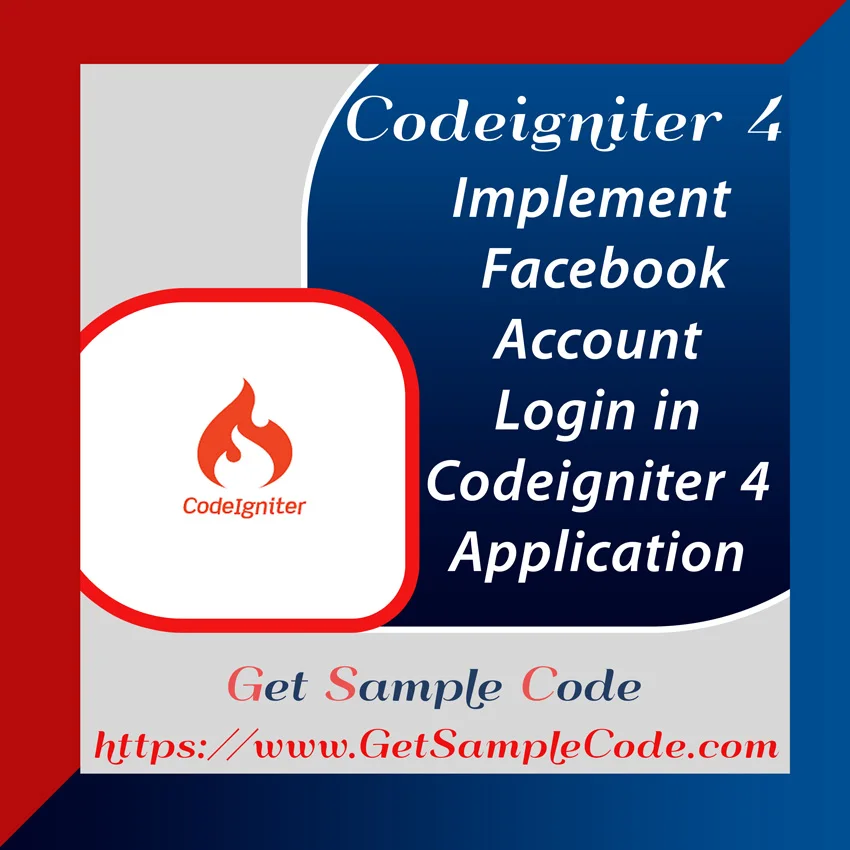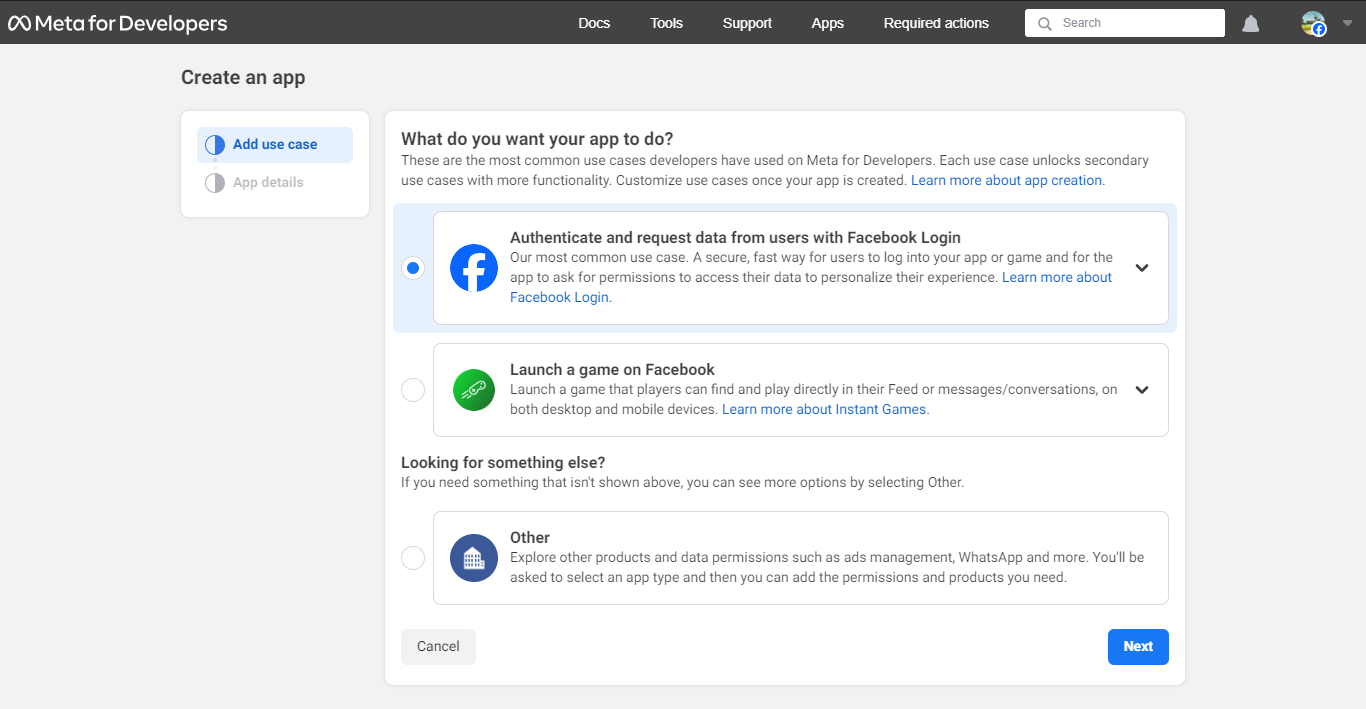Login with Facebook Account in CodeIgniter 4 - Step-by-Step Guide
Implementing Facebook account authentication is very popular these days. It is an easy and powerful method for user authentication, allowing users to log in with their Facebook accounts. This method reduces the effort required for registration or login, as users don't need to remember separate usernames and passwords.
Table Of Content
1 Prerequisites
1.) PHP version of 8.2
2.) Composer
3.) Facebook SDK
2 Introduction
In this article, we will explore how to implement Login with Facebook in CodeIgniter using the Facebook SDK. We'll be integrating Login Facebook via Oauth 2.0 in a CodeIgniter 4 application to authenticate users through their Facebook accounts.
3 Install Codeigniter 4 Project
First, make sure your computer has a composer.
Use the following command to install new Codeigniter Project.
composer create-project codeigniter4/appstarter ci-4-facebook-signin-app
cd ci-4-facebook-signin-app
4 Install Facebook SDK
First, make sure your computer has a composer.
Use the following command to install Facebook SDK via Composer.
composer require facebook/graph-sdk
5 Create Facebook App Credentials
5.1 Login into Facebook Developers Portal
If you have Facebook Developer Account Go to https://developers.facebook.com/, else you can easily create one directly from the Facebook Developers Portal.
5.2 Create a Facebook App
Click on "Create App" Button and follow the prompts to create a new Facebook App

5.3 Configure OAuth Settings
In Following Screen select "Authenticate and request data from users with Facebook Login" Option


Fill the Details of the App in following Screen and Press " Create App " Button

In the Facebook App dashboard, navigate to " App Settings" Menu and then "Basic"

Now Copy App Id and App Secret to update in .env file and enter the website Domain URL in App Domains field, Again Scroll down in same screen to "Add Platform" details then Select Website and update Site URL.


5.4 Update App Information
Now go to "Use Cases" tab then click "Customize" Button and select "settings" option


Now fill the authorised redirect URIs. This is the URI that we will use to redirect user after they choose their Facebook account to login to our web. For example here I use http://127.0.0.1:8000/callback/facebook for the callback URI..

6 Configure Facebook App Credentials
Insert the Facebook App ID and Facebook App Secret key and redirect URI into the .env file, Which we obtained from previous step FACEBOOK_APP_ID and FACEBOOK_APP_SECRET. Additionally, include a new key in the .env file called FACEBOOK_REDIRECT_URI and populate it with the callback URI used in the Facebook/Meta Admin.
FACEBOOK_APP_ID=Your Client ID
FACEBOOK_APP_SECRET=Your Client Secret
FACEBOOK_REDIRECT_URI=http://127.0.0.1:8000/auth/facebook_callback
7 Create New Controller - FaceookAuthController
Create a new controller to handle Facebook login functionality. Use the following artisan command:
php spark make:controller FaceookAuthController
<?php
namespace App\Controllers;
use CodeIgniter\Controller;
use Facebook\Facebook;
class FaceookAuthController extends Controller
{
private $facebook;
public function __construct()
{
$this->facebook = new Facebook([
'app_id' => getenv('FACEBOOK_APP_ID'),
'app_secret' => getenv('FACEBOOK_APP_SECRET'),
'default_graph_version' => 'v12.0',
]);
}
public function Login()
{
return view('index');
}
public function facebookLogin()
{
$helper = $this->facebook->getRedirectLoginHelper();
$permissions = ['email']; // Optional permissions
$loginUrl = $helper->getLoginUrl(getenv('FACEBOOK_REDIRECT_URI'), $permissions);
return redirect()->to($loginUrl);
}
public function facebookCallback()
{
$helper = $this->facebook->getRedirectLoginHelper();
try {
$accessToken = $helper->getAccessToken();
} catch (\Facebook\Exceptions\FacebookResponseException $e) {
// When Graph returns an error
return redirect()->to('/login')->with('error', 'Graph returned an error: ' . $e->getMessage());
} catch (\Facebook\Exceptions\FacebookSDKException $e) {
// When validation fails or other local issues
return redirect()->to('/login')->with('error', 'Facebook SDK returned an error: ' . $e->getMessage());
}
if (!isset($accessToken)) {
if ($helper->getError()) {
return redirect()->to('/login')->with('error', "Error: " . $helper->getError() . "\n");
} else {
return redirect()->to('/login')->with('error', 'Bad request');
}
}
// OAuth 2.0 client handler
$oAuth2Client = $this->facebook->getOAuth2Client();
// Exchanges a short-lived access token for a long-lived one
$accessToken = $oAuth2Client->getLongLivedAccessToken($accessToken);
// Get user info from Facebook
try {
$response = $this->facebook->get('/me?fields=id,name,email', $accessToken);
} catch (\Facebook\Exceptions\FacebookResponseException $e) {
return redirect()->to('/login')->with('error', 'Graph returned an error: ' . $e->getMessage());
} catch (\Facebook\Exceptions\FacebookSDKException $e) {
return redirect()->to('/login')->with('error', 'Facebook SDK returned an error: ' . $e->getMessage());
}
$user = $response->getGraphUser();
// Store user data in session or database
$session = session();
$session->set([
'id' => $user['id'],
'name' => $user['name'],
'email' => $user['email'],
'is_logged_in' => true,
]);
return redirect()->to('/dashboard');
}
public function dashboard()
{
$session = session();
$is_logged_in = $session->get('is_logged_in');
if($is_logged_in)
{
$data=array();
$data['name']=$session->get('name');
$data['id']=$session->get('id');
$data['email']=$session->get('email');
return view('dashboard',$data);
}else
return redirect()->to('/login');
}
public function logout()
{
$session = session();
$session->destroy();
return redirect()->to('/login');
}
}
?>
8 Create Index View File
Design the view in app/Views/index.php to include the login button and initiate the Login with Facebook in CodeIgniter process.
<!DOCTYPE html>
<html lang="en">
<head>
<meta http-equiv="content-type" content="text/html; charset=utf-8">
<meta name="viewport" content="width=device-width, initial-scale=1.0">
<meta http-equiv="X-UA-Compatible" content="ie=edge">
<meta http-equiv="Content-Security-Policy" content="default-src * self blob: data: gap:; style-src * self 'unsafe-inline' blob: data: gap:; script-src * 'self' 'unsafe-eval' 'unsafe-inline' blob: data: gap:; object-src * 'self' blob: data: gap:; img-src * self 'unsafe-inline' blob: data: gap:; connect-src self * 'unsafe-inline' blob: data: gap:; frame-src * self blob: data: gap:;">
<title>Codeigniter Posts | GetSampleCode.com</title>
<meta name="title" content="Codeigniter Posts | GetSampleCode.com">
<meta name="description" content="GetSampleCode.com provides Sample Code and tutorials for all web language and frameworks, PHP, Laravel, Codeigniter, API, MySQL, AJAX, jQuery">
<meta name="keywords" content="Programming Blog, Sample Web Development Code, PHP Code, CodeIgniter, Laravel 11, jQuery, MySQL, AJAX, bootstrap, HTML, CSS, JavaScript, Live Demo">
<meta name="robots" content="index, follow">
<meta http-equiv="Content-Type" content="text/html; charset=utf-8">
<meta name="language" content="English">
<link rel="canonical" href="https://getsamplecode.com/category/codeigniter">
<!-- Open Graph / Facebook Meta Tags -->
<meta property="og:type" content="website">
<meta property="og:url" content="https://www.getsamplecode.com">
<meta property="og:title" content="Codeigniter Posts | GetSampleCode.com">
<meta property="og:description" content="GetSampleCode.com provides Sample Code and tutorials for all web language and frameworks, PHP, Laravel, Codeigniter, API, MySQL, AJAX, jQuery">
<meta property="og:image" content="https://www.getsamplecode.com/get_sample_code_logo.jpg">
<!-- Twitter Meta Tags -->
<meta name="twitter:card" content="summary_large_image">
<meta name="twitter:url" content="https://www.getsamplecode.com">
<meta name="twitter:title" content="Codeigniter Posts | GetSampleCode.com">
<meta name="twitter:description" content="GetSampleCode.com provides Sample Code and tutorials for all web language and frameworks, PHP, Laravel, Codeigniter, API, MySQL, AJAX, jQuery">
<meta name="twitter:image" content="https://www.getsamplecode.com/get_sample_code_logo.jpg">
<link rel="preconnect" href="https://fonts.gstatic.com">
<link href="https://fonts.googleapis.com/css2?family=Inter:wght@100;200;300;400;500;600;700;800&display=swap" rel="stylesheet">
<link rel="icon" sizes="16x16" href="https://getsamplecode.com/fassets/img/fav_icon.png">
<link rel="stylesheet" href="https://getsamplecode.com/fassets/css/bootstrap.min.css">
<link rel="stylesheet" href="https://getsamplecode.com/fassets/css/line-awesome.css">
<link rel="stylesheet" href="https://getsamplecode.com/fassets/css/style.css">
<link rel="stylesheet" href="https://getsamplecode.com/fassets/css/custom.css">
<link rel="stylesheet" href="https://getsamplecode.com/fassets/css/toc.css">
<link rel="stylesheet" href="https://getsamplecode.com/fassets/css/prism/prism.css">
<link rel="stylesheet" href="https://getsamplecode.com/fassets/css/folder.css">
<style>
.form--control
{
padding-left:15px;
}
.login-with-google-btn {
transition: background-color .3s, box-shadow .3s;
padding: 12px 16px 12px 42px;
border: none;
border-radius: 3px;
box-shadow: 0 -1px 0 rgba(0, 0, 0, .04), 0 1px 1px rgba(0, 0, 0, .25);
color: #757575;
font-size: 14px;
font-weight: 500;
font-family: -apple-system,BlinkMacSystemFont,"Segoe UI",Roboto,Oxygen,Ubuntu,Cantarell,"Fira Sans","Droid Sans","Helvetica Neue",sans-serif;
background-image: url(data:image/svg+xml;base64,PHN2ZyB3aWR0aD0iMTgiIGhlaWdodD0iMTgiIHhtbG5zPSJodHRwOi8vd3d3LnczLm9yZy8yMDAwL3N2ZyI+PGcgZmlsbD0ibm9uZSIgZmlsbC1ydWxlPSJldmVub2RkIj48cGF0aCBkPSJNMTcuNiA5LjJsLS4xLTEuOEg5djMuNGg0LjhDMTMuNiAxMiAxMyAxMyAxMiAxMy42djIuMmgzYTguOCA4LjggMCAwIDAgMi42LTYuNnoiIGZpbGw9IiM0Mjg1RjQiIGZpbGwtcnVsZT0ibm9uemVybyIvPjxwYXRoIGQ9Ik05IDE4YzIuNCAwIDQuNS0uOCA2LTIuMmwtMy0yLjJhNS40IDUuNCAwIDAgMS04LTIuOUgxVjEzYTkgOSAwIDAgMCA4IDV6IiBmaWxsPSIjMzRBODUzIiBmaWxsLXJ1bGU9Im5vbnplcm8iLz48cGF0aCBkPSJNNCAxMC43YTUuNCA1LjQgMCAwIDEgMC0zLjRWNUgxYTkgOSAwIDAgMCAwIDhsMy0yLjN6IiBmaWxsPSIjRkJCQzA1IiBmaWxsLXJ1bGU9Im5vbnplcm8iLz48cGF0aCBkPSJNOSAzLjZjMS4zIDAgMi41LjQgMy40IDEuM0wxNSAyLjNBOSA5IDAgMCAwIDEgNWwzIDIuNGE1LjQgNS40IDAgMCAxIDUtMy43eiIgZmlsbD0iI0VBNDMzNSIgZmlsbC1ydWxlPSJub256ZXJvIi8+PHBhdGggZD0iTTAgMGgxOHYxOEgweiIvPjwvZz48L3N2Zz4=);
background-color: white;
background-repeat: no-repeat;
background-position: 12px 11px;
&:hover {
box-shadow: 0 -1px 0 rgba(0, 0, 0, .04), 0 2px 4px rgba(0, 0, 0, .25);
}
&:active {
background-color: #eeeeee;
}
&:focus {
outline: none;
box-shadow:
0 -1px 0 rgba(0, 0, 0, .04),
0 2px 4px rgba(0, 0, 0, .25),
0 0 0 3px #c8dafc;
}
&:disabled {
filter: grayscale(100%);
background-color: #ebebeb;
box-shadow: 0 -1px 0 rgba(0, 0, 0, .04), 0 1px 1px rgba(0, 0, 0, .25);
cursor: not-allowed;
}
}
</style>
</style>
</head>
<body>
<div class="preloader">
<div class="loader">
<svg class="spinner" viewBox="0 0 50 50">
<circle class="path" cx="25" cy="25" r="20" fill="none" stroke-width="5"></circle>
</svg>
</div>
</div>
<header class="header-menu-area bg-white">
<!-- end header-top -->
<div class="header-menu-content pr-150px pl-150px bg-white" style="padding:15px">
<div class="container-fluid">
<div class="main-menu-content">
<div class="row align-items-center">
<div class="col-lg-9">
<div class="logo-box">
<a href="https://getsamplecode.com" class="logo"><img src="https://getsamplecode.com/fassets/img/get_sample_code_logo.png" alt="logo"></a>
<div class="user-btn-action">
<div class="search-menu-toggle icon-element icon-element-sm shadow-sm mr-2" data-toggle="tooltip" data-placement="top" title="Search">
<i class="la la-search"></i>
</div>
<div class="off-canvas-menu-toggle main-menu-toggle icon-element icon-element-sm shadow-sm" data-toggle="tooltip" data-placement="top" title="Main menu">
<i class="la la-bars"></i>
</div>
</div>
</div>
</div><!-- end col-lg-2 -->
</div><!-- end row -->
</div>
</div><!-- end container-fluid -->
</div><!-- end header-menu-content -->
<!-- end off-canvas-menu -->
<div class="body-overlay"></div>
</header><!-- end header-menu-area -->
<!--======================================
END HEADER AREA
======================================-->
<section class="breadcrumb-area pt-50px pb-50px bg-white pattern-bg">
<div class="container">
<div class="col-lg-12 me-auto">
<div class="breadcrumb-content">
<div class="section-heading">
<h2 class="section__title">
Live Demo: Login with Facebook Account using Codeingiter 4
</h2>
</div>
</div>
</div>
</div>
</section>
<section class="blog-area" style="padding-top:30px;">
<div class="container-fluid">
<!-- end filter-bar -->
<div class="row">
<div class="col-lg-3 mb-5"></div>
<div class="col-lg-6 mb-5">
<div class="card card-item">
<div class="card-body">
<a href="<?= base_url('auth/google') ?>">
<button type="button" class="login-with-google-btn" fdprocessedid="buigfs">
Sign in with Facebook
</button>
</a>
<a href="<?= base_url('auth/facebook') ?>">Login with Facebook</a>
</div>
</div>
</div>
<div class="col-lg-3 mb-5"></div>
</div>
</div>
</section>
<div class="toggle"></div>
<section class="footer-area bg-gray" style="background-color:#eee !important">
<div class="section-block"></div>
<div class="copyright-content" style="padding:10px">
<div class="container">
<div class="row align-items-center">
<div class="col-lg-6">
<p class="copy-desc">© 2024 Get Sample Code. All Rights Reserved. </p>
</div><!-- end col-lg-6 -->
<div class="col-lg-6">
<div class="d-flex flex-wrap align-items-center justify-content-end">
<ul class="generic-list-item d-flex flex-wrap align-items-center fs-14">
<li class="mr-3"><a href="https://getsamplecode.com/terms-and-conditions">Terms & Conditions</a></li>
<li class="mr-3"><a href="https://getsamplecode.com/privacy-policy">Privacy Policy</a></li>
<li class="mr-3"><a href="https://getsamplecode.com/disclaimer">Disclaimer</a></li>
</ul>
</div>
</div><!-- end col-lg-6 -->
</div><!-- end row -->
</div><!-- end container -->
</div><!-- end copyright-content -->
</section><!-- end footer-area -->
<div id="scroll-top">
<i class="la la-arrow-up" title="Go top"></i>
</div>
<script src="https://getsamplecode.com/fassets/js/jquery-3.4.1.min.js"></script>
<script src="https://getsamplecode.com/fassets/js/bootstrap.bundle.min.js"></script>
<script src="https://getsamplecode.com/fassets/js/jquery.lazy.min.js"></script>
<script src="https://getsamplecode.com/fassets/js/main.js"></script>
<script src="https://getsamplecode.com/fassets/js/prism/prism.js"></script>
<script src="https://getsamplecode.com/fassets/js/folder.js"></script>
<script type="text/javascript">
const toggle = document.querySelector(".toggle");
const nav_bar = document.querySelector(".table-of-contents");
const list = document.querySelector(".table__list");
toggle.addEventListener("click", ()=>{
if (toggle.textContent === "hide") {
toggle.textContent = "show";
}
else {
toggle.textContent = "hide";
}
list.classList.toggle("list-invisible");
nav_bar.classList.toggle("table-narrow");
});
function search_form()
{
$("#search_form").submit();
}
function search_form_mobile()
{
$("#search_form_mobile").submit();
}
function search_form_sidepanel()
{
$("#search_form_sidepanel").submit();
}
</script>
</body>
</html>
9 Create Dashboard View File
Create View "dashboard.php" File to Show Form
app/Views/dashboard.php
<!DOCTYPE html>
<html lang="en">
<head>
<meta http-equiv="content-type" content="text/html; charset=utf-8">
<meta name="viewport" content="width=device-width, initial-scale=1.0">
<meta http-equiv="X-UA-Compatible" content="ie=edge">
<meta http-equiv="Content-Security-Policy" content="default-src * self blob: data: gap:; style-src * self 'unsafe-inline' blob: data: gap:; script-src * 'self' 'unsafe-eval' 'unsafe-inline' blob: data: gap:; object-src * 'self' blob: data: gap:; img-src * self 'unsafe-inline' blob: data: gap:; connect-src self * 'unsafe-inline' blob: data: gap:; frame-src * self blob: data: gap:;">
<title>Codeigniter Posts | GetSampleCode.com</title>
<meta name="title" content="Codeigniter Posts | GetSampleCode.com">
<meta name="description" content="GetSampleCode.com provides Sample Code and tutorials for all web language and frameworks, PHP, Laravel, Codeigniter, API, MySQL, AJAX, jQuery">
<meta name="keywords" content="Programming Blog, Sample Web Development Code, PHP Code, CodeIgniter, Laravel 11, jQuery, MySQL, AJAX, bootstrap, HTML, CSS, JavaScript, Live Demo">
<meta name="robots" content="index, follow">
<meta http-equiv="Content-Type" content="text/html; charset=utf-8">
<meta name="language" content="English">
<link rel="canonical" href="https://getsamplecode.com/category/codeigniter">
<!-- Open Graph / Facebook Meta Tags -->
<meta property="og:type" content="website">
<meta property="og:url" content="https://www.getsamplecode.com">
<meta property="og:title" content="Codeigniter Posts | GetSampleCode.com">
<meta property="og:description" content="GetSampleCode.com provides Sample Code and tutorials for all web language and frameworks, PHP, Laravel, Codeigniter, API, MySQL, AJAX, jQuery">
<meta property="og:image" content="https://www.getsamplecode.com/get_sample_code_logo.jpg">
<!-- Twitter Meta Tags -->
<meta name="twitter:card" content="summary_large_image">
<meta name="twitter:url" content="https://www.getsamplecode.com">
<meta name="twitter:title" content="Codeigniter Posts | GetSampleCode.com">
<meta name="twitter:description" content="GetSampleCode.com provides Sample Code and tutorials for all web language and frameworks, PHP, Laravel, Codeigniter, API, MySQL, AJAX, jQuery">
<meta name="twitter:image" content="https://www.getsamplecode.com/get_sample_code_logo.jpg">
<link rel="preconnect" href="https://fonts.gstatic.com">
<link href="https://fonts.googleapis.com/css2?family=Inter:wght@100;200;300;400;500;600;700;800&display=swap" rel="stylesheet">
<link rel="icon" sizes="16x16" href="https://getsamplecode.com/fassets/img/fav_icon.png">
<link rel="stylesheet" href="https://getsamplecode.com/fassets/css/bootstrap.min.css">
<link rel="stylesheet" href="https://getsamplecode.com/fassets/css/line-awesome.css">
<link rel="stylesheet" href="https://getsamplecode.com/fassets/css/style.css">
<link rel="stylesheet" href="https://getsamplecode.com/fassets/css/custom.css">
<link rel="stylesheet" href="https://getsamplecode.com/fassets/css/toc.css">
<link rel="stylesheet" href="https://getsamplecode.com/fassets/css/prism/prism.css">
<link rel="stylesheet" href="https://getsamplecode.com/fassets/css/folder.css">
<style>
.form--control
{
padding-left:15px;
}
.login-with-google-btn {
transition: background-color .3s, box-shadow .3s;
padding: 12px 16px 12px 42px;
border: none;
border-radius: 3px;
box-shadow: 0 -1px 0 rgba(0, 0, 0, .04), 0 1px 1px rgba(0, 0, 0, .25);
color: #757575;
font-size: 14px;
font-weight: 500;
font-family: -apple-system,BlinkMacSystemFont,"Segoe UI",Roboto,Oxygen,Ubuntu,Cantarell,"Fira Sans","Droid Sans","Helvetica Neue",sans-serif;
background-image: url(data:image/svg+xml;base64,PHN2ZyB3aWR0aD0iMTgiIGhlaWdodD0iMTgiIHhtbG5zPSJodHRwOi8vd3d3LnczLm9yZy8yMDAwL3N2ZyI+PGcgZmlsbD0ibm9uZSIgZmlsbC1ydWxlPSJldmVub2RkIj48cGF0aCBkPSJNMTcuNiA5LjJsLS4xLTEuOEg5djMuNGg0LjhDMTMuNiAxMiAxMyAxMyAxMiAxMy42djIuMmgzYTguOCA4LjggMCAwIDAgMi42LTYuNnoiIGZpbGw9IiM0Mjg1RjQiIGZpbGwtcnVsZT0ibm9uemVybyIvPjxwYXRoIGQ9Ik05IDE4YzIuNCAwIDQuNS0uOCA2LTIuMmwtMy0yLjJhNS40IDUuNCAwIDAgMS04LTIuOUgxVjEzYTkgOSAwIDAgMCA4IDV6IiBmaWxsPSIjMzRBODUzIiBmaWxsLXJ1bGU9Im5vbnplcm8iLz48cGF0aCBkPSJNNCAxMC43YTUuNCA1LjQgMCAwIDEgMC0zLjRWNUgxYTkgOSAwIDAgMCAwIDhsMy0yLjN6IiBmaWxsPSIjRkJCQzA1IiBmaWxsLXJ1bGU9Im5vbnplcm8iLz48cGF0aCBkPSJNOSAzLjZjMS4zIDAgMi41LjQgMy40IDEuM0wxNSAyLjNBOSA5IDAgMCAwIDEgNWwzIDIuNGE1LjQgNS40IDAgMCAxIDUtMy43eiIgZmlsbD0iI0VBNDMzNSIgZmlsbC1ydWxlPSJub256ZXJvIi8+PHBhdGggZD0iTTAgMGgxOHYxOEgweiIvPjwvZz48L3N2Zz4=);
background-color: white;
background-repeat: no-repeat;
background-position: 12px 11px;
&:hover {
box-shadow: 0 -1px 0 rgba(0, 0, 0, .04), 0 2px 4px rgba(0, 0, 0, .25);
}
&:active {
background-color: #eeeeee;
}
&:focus {
outline: none;
box-shadow:
0 -1px 0 rgba(0, 0, 0, .04),
0 2px 4px rgba(0, 0, 0, .25),
0 0 0 3px #c8dafc;
}
&:disabled {
filter: grayscale(100%);
background-color: #ebebeb;
box-shadow: 0 -1px 0 rgba(0, 0, 0, .04), 0 1px 1px rgba(0, 0, 0, .25);
cursor: not-allowed;
}
}
</style>
</style>
</head>
<body>
<div class="preloader">
<div class="loader">
<svg class="spinner" viewBox="0 0 50 50">
<circle class="path" cx="25" cy="25" r="20" fill="none" stroke-width="5"></circle>
</svg>
</div>
</div>
<header class="header-menu-area bg-white">
<!-- end header-top -->
<div class="header-menu-content pr-150px pl-150px bg-white" style="padding:15px">
<div class="container-fluid">
<div class="main-menu-content">
<div class="row align-items-center">
<div class="col-lg-9">
<div class="logo-box">
<a href="https://getsamplecode.com" class="logo"><img src="https://getsamplecode.com/fassets/img/get_sample_code_logo.png" alt="logo"></a>
<div class="user-btn-action">
<div class="search-menu-toggle icon-element icon-element-sm shadow-sm mr-2" data-toggle="tooltip" data-placement="top" title="Search">
<i class="la la-search"></i>
</div>
<div class="off-canvas-menu-toggle main-menu-toggle icon-element icon-element-sm shadow-sm" data-toggle="tooltip" data-placement="top" title="Main menu">
<i class="la la-bars"></i>
</div>
</div>
</div>
</div><!-- end col-lg-2 -->
</div><!-- end row -->
</div>
</div><!-- end container-fluid -->
</div><!-- end header-menu-content -->
<!-- end off-canvas-menu -->
<div class="body-overlay"></div>
</header><!-- end header-menu-area -->
<!--======================================
END HEADER AREA
======================================-->
<section class="breadcrumb-area pt-50px pb-50px bg-white pattern-bg">
<div class="container">
<div class="col-lg-12 me-auto">
<div class="breadcrumb-content">
<div class="section-heading">
<h2 class="section__title">
Live Demo: Login with Facebook Account using Codeingiter 4
</h2>
</div>
</div>
</div>
</div>
</section>
<section class="blog-area" style="padding-top:30px;">
<div class="container-fluid">
<!-- end filter-bar -->
<div class="row">
<div class="col-lg-3 mb-5"></div>
<div class="col-lg-6 mb-5">
<div class="card card-item">
<div class="card-body">
<center><h2>Facebook Account Details</h2></center>
<hr />
<p><b>Facebook ID:</b><?php echo $id;?></p>
<p><b>Name:</b><?php echo $name;?></p>
<p><b>Email:</b><?php echo $email;?></p>
<p>Logout from <a href="<?= base_url('logout') ?>">Facebook</a></p>
</div>
</div>
</div>
<div class="col-lg-3 mb-5"></div>
</div>
</div>
</section>
<div class="toggle"></div>
<section class="footer-area bg-gray" style="background-color:#eee !important">
<div class="section-block"></div>
<div class="copyright-content" style="padding:10px">
<div class="container">
<div class="row align-items-center">
<div class="col-lg-6">
<p class="copy-desc">© 2024 Get Sample Code. All Rights Reserved. </p>
</div><!-- end col-lg-6 -->
<div class="col-lg-6">
<div class="d-flex flex-wrap align-items-center justify-content-end">
<ul class="generic-list-item d-flex flex-wrap align-items-center fs-14">
<li class="mr-3"><a href="https://getsamplecode.com/terms-and-conditions">Terms & Conditions</a></li>
<li class="mr-3"><a href="https://getsamplecode.com/privacy-policy">Privacy Policy</a></li>
<li class="mr-3"><a href="https://getsamplecode.com/disclaimer">Disclaimer</a></li>
</ul>
</div>
</div><!-- end col-lg-6 -->
</div><!-- end row -->
</div><!-- end container -->
</div><!-- end copyright-content -->
</section><!-- end footer-area -->
<div id="scroll-top">
<i class="la la-arrow-up" title="Go top"></i>
</div>
<script src="https://getsamplecode.com/fassets/js/jquery-3.4.1.min.js"></script>
<script src="https://getsamplecode.com/fassets/js/bootstrap.bundle.min.js"></script>
<script src="https://getsamplecode.com/fassets/js/jquery.lazy.min.js"></script>
<script src="https://getsamplecode.com/fassets/js/main.js"></script>
<script src="https://getsamplecode.com/fassets/js/prism/prism.js"></script>
<script src="https://getsamplecode.com/fassets/js/folder.js"></script>
<script type="text/javascript">
const toggle = document.querySelector(".toggle");
const nav_bar = document.querySelector(".table-of-contents");
const list = document.querySelector(".table__list");
toggle.addEventListener("click", ()=>{
if (toggle.textContent === "hide") {
toggle.textContent = "show";
}
else {
toggle.textContent = "hide";
}
list.classList.toggle("list-invisible");
nav_bar.classList.toggle("table-narrow");
});
function search_form()
{
$("#search_form").submit();
}
function search_form_mobile()
{
$("#search_form_mobile").submit();
}
function search_form_sidepanel()
{
$("#search_form_sidepanel").submit();
}
</script>
</body>
</html>
10 Define a Route
Define routes for the UploadController in the Routes.php file
app/Config/Routes.php
use CodeIgniter\Router\RouteCollection;
/**
* @var RouteCollection $routes
*/
$routes->get('/', 'Home::index');
$routes->get('auth/facebook', 'FaceookAuthController::facebookLogin');
$routes->get('auth/facebook_callback', 'FaceookAuthController::facebookCallback');
$routes->get('login', 'FaceookAuthController::Login');
$routes->get('dashboard', 'FaceookAuthController::dashboard');
$routes->get('logout', 'FaceookAuthController::logout');
11 Folder Structure
Ensure the folder structure is correctly set up with controllers, views, and routes to maintain the app's organization.
12 Run Web Server to Test the App
Finally, run your development server to test Login with Facebook Account in CodeIgniter 4 functionality:
php spark serve
13 Conclusion
By following these steps, you can easily implement Login with Facebook in CodeIgniter 4. This method simplifies user authentication by using Login Facebook via Oauth 2.0, providing a seamless experience for users logging into your CodeIgniter 4 application.







